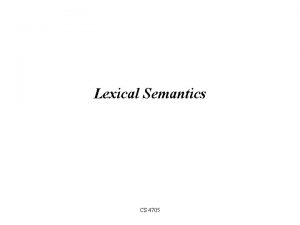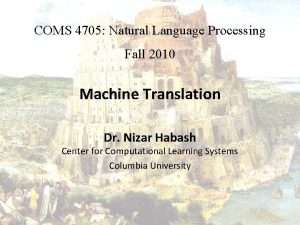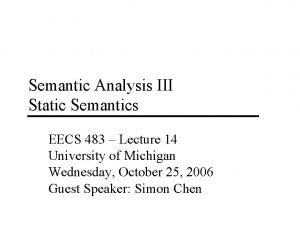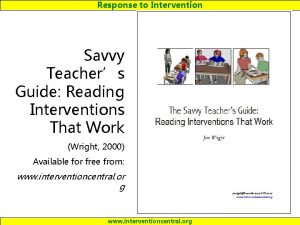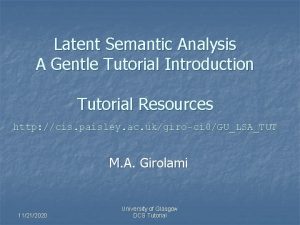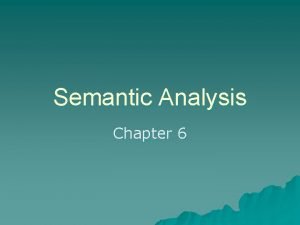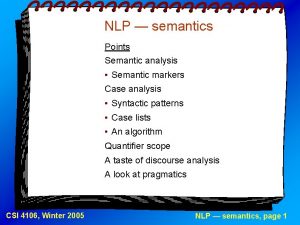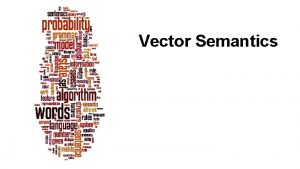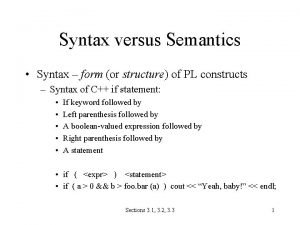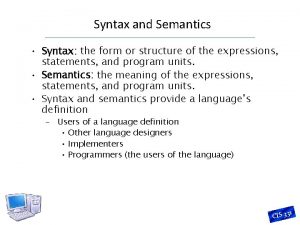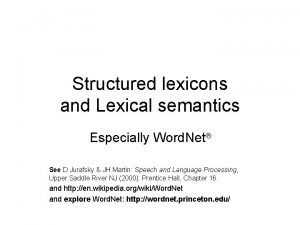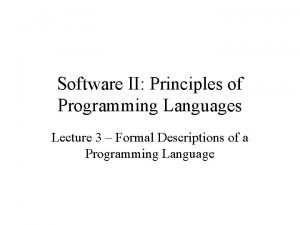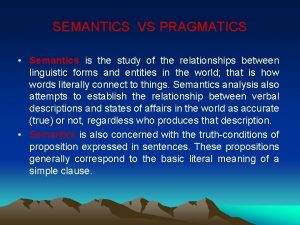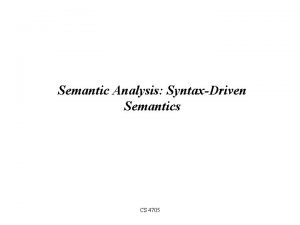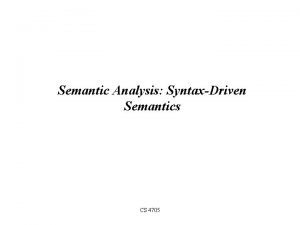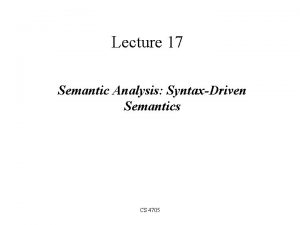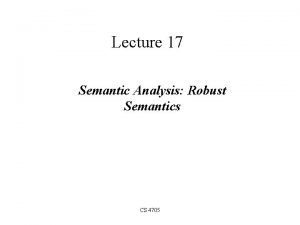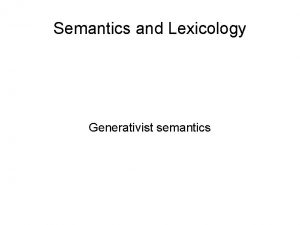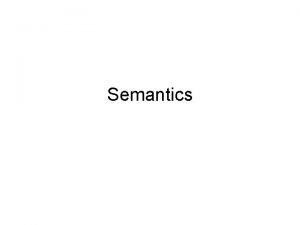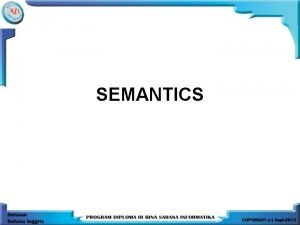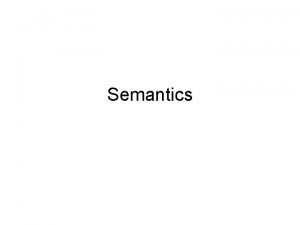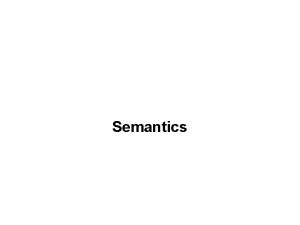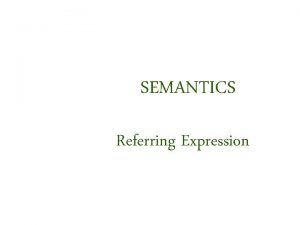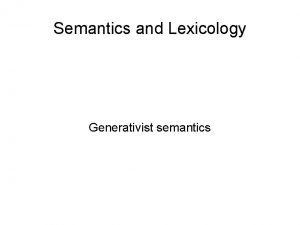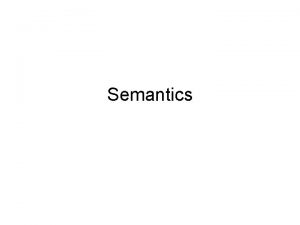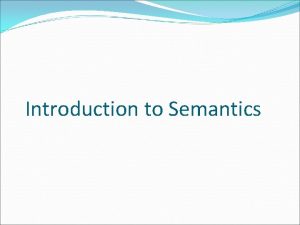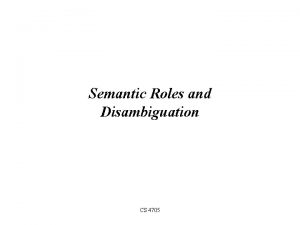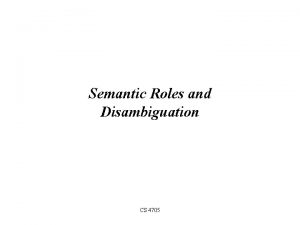CS 4705 Semantic Analysis SyntaxDriven Semantics CS 4705



















- Slides: 19

CS 4705 Semantic Analysis: Syntax-Driven Semantics CS 4705

Meaning derives from – The entities and actions/states represented (predicates and arguments, or, nouns and verbs) – The way they are ordered and related: • The syntax of the representation may correspond to the syntax of the sentence • Can we develop a mapping between syntactic representations and formal representations of meaning?

Syntax-Driven Semantics S NP VP eat(Dan) Nom V N Dan eats • Goal: Link syntactic structures to corresponding semantic representation to produce representation of the ‘meaning’ of a sentence while parsing it

Specific vs. General-Purpose Rules • Don’t want to have to specify for every possible parse tree what semantic representation it maps to • Do want to identify general mappings from parse trees to semantic representations • One way: – Augment lexicon and grammar – Devise mapping between rules of grammar and rules of semantic representation – Rule-to-Rule Hypothesis: such a mapping exists

Semantic Attachment • Extend every grammar rule with `instructions’ on how to map components of rule to a semantic representation, e. g. S NP VP {VP. sem(NP. sem)} • Each semantic function defined in terms of semantic representation of choice • Problem: how to define semantic functions and how to specify their composition so we always get the `right’ meaning representation from the grammar

Example: Mc. Donalds serves burgers. • Associating constants with constituents – Proper. Noun Mc. Donalds {Mc. Donalds} – Plural. Noun burgers {burgers} • Defining functions to produce these from input – NP Proper. Noun {Proper. Noun. sem} – NP Plural. Noun {Plural. Noun. sem} – Assumption: meaning representations of children are passed up to parents when nonbranching (e. g. Proper. Noun. sem(X) = X) • But…verbs are where the action is

– V serves {E(e, x, y) (Isa(e, Serving) ^ Server(e, x) ^ Served(e, y))} where e = event, x = agent, y = patient – Will every verb needs its own distinct representation? Mc. Donalds hires students. • Predicate(Agent, Patient) Mc. Donalds gave customers a bonus. • Predicate(Agent, Patient, Beneficiary)

Composing Semantic Constituents • Once we have the semantics for each constituent, how do we combine them? – E. g. VP V NP {V. sem(NP. sem)} – If goal for VP semantics of ‘serve’ is the representation E(e, x) (Isa(e, Serving) ^ Server(e, x) ^ Served(e, Meat)) then – VP. sem must tell us • Which variables to be replaced by which arguments? • How is replacement accomplished?

First… Lambda Notation • Extension to First Order Predicate Calculus λ x P(x): λ + variable(s) + FOPC expression in those variables • Lambda reduction • Apply lambda-expression to logical terms to bind lambda-expression’s parameters to terms x. P(x)(car) P(car)

For NLP Semantics • Parameter list (e. g. x in x) in lambda expression makes variables (x) in logical expression (P(x)) available for binding to external arguments (car) provided by semantics of other constituents

Defining VP Semantics • Recall we have VP V NP {V. sem(NP. sem)} • Target semantic representation is: {E(e, x, y) (Isa(e, Serving) ^ Server(e, y) ^ Served(e, x))} • Define V. sem as: { x E(e, y) (Isa(e, Serving) ^ Server(e, y) ^ Served(e, x))} – Now ‘x’ will be available for binding when V. sem applied to NP. sem of direct object

V. sem Applied to Mc. Donalds serves burgers • application binds x to value of NP. sem (burgers) x E(e, y) (Isa(e, Serving) ^ Server(e, y) ^ Served(e, x)) (burgers) • -reduction replaces x within -expression with burgers • Value of V. sem(NP. sem) is now E(e, y) (Isa(e, Serving) ^ Server(e, y) ^ Served(e, burgers))

But we’re not done yet…. • Need to define semantics for – S NP VP {VP. sem(NP. sem)} – Where is the subject? – E(e, y) (Isa(e, Serving) ^ Server(e, y) ^ Served(e, burgers)) – Need another -expression in V. sem so the subject NP can be bound later in VP. sem – V. sem, version 2 • x y E(e) (Isa(e, Serving) ^ Server(e, y) ^ Served(e, x))

– VP V NP {V. sem(NP. sem)} x y E(e) (Isa(e, Serving) ^ Server(e, y) ^ Served(e, x))(burgers) y E(e) (Isa(e, Serving) ^ Server(e, y) ^ Served(e, burgers)) – S NP VP {VP. sem(NP. sem)} y E(e) Isa(e, Serving) ^ Server(e, y) ^ Served(e, burgers)}(Mc. Donald’s) E(e) Isa(e, Serving) ^ Server(e, Mc. Donald’s) ^ Served(e, burgers)

What is our grammar now? S NP VP {VP. sem(NP. sem)} VP V NP {V. sem(NP. sem)} V serves { x y E(e) (Isa(e, Serving) ^ Server(e, y) ^ Served(e, x))} NP Propernoun {Propernoun. sem} NP Pluralnow {Pluralnoun. sem} Propernoun Mc. Donalds Pluralnoun burgers

Doing Compositional Semantics • To incorporate semantics into grammar we must – Determine `right’ representation for each basic constituent – Determine `right’ representation constituents that take these basic constituents as arguments – Incorporate semantic attachments into each rule of our CFG

Parsing with Semantic Attachments • Modify parser to include operations on semantic attachments as well as syntactic constituents – E. g. , change an Early-style parser so when constituents are completed, their attached semantic function is applied and a meaning representation created and stored with state • Or… let parser run to completion and then walk through resulting tree, applying semantic attachments from bottom-up

Summing Up • Hypothesis: Principle of Compositionality – Semantics of NL sentences and phrases can be composed from the semantics of their subparts • Rules can be derived which map syntactic analysis to semantic representation (Rule-to-Rule Hypothesis) – Lambda notation provides a way to extend FOPC to this end – But coming up with rule 2 rule mappings is hard • Idioms, metaphors and other non-compositional aspects of language makes things tricky (e. g. fake gun)

Next • Read Ch 16: 1 -2
 Compare procedural semantics and declarative semantics.
Compare procedural semantics and declarative semantics. 4705 in word
4705 in word Today meaning
Today meaning Coms 4705
Coms 4705 Static semantic analysis
Static semantic analysis Semantic feature analysis example
Semantic feature analysis example Latent semantic indexing tutorial
Latent semantic indexing tutorial Sementic
Sementic Static semantic analysis
Static semantic analysis Semantic markers examples
Semantic markers examples Semantic analysis definition
Semantic analysis definition What is sementic
What is sementic Aki karusmäki
Aki karusmäki Vector semantics
Vector semantics Scope of semantics
Scope of semantics Semantics syntax
Semantics syntax Syntax vs semantics
Syntax vs semantics Lexicon semantics
Lexicon semantics Parse tree for if else statement
Parse tree for if else statement Pragmatics vs semantics
Pragmatics vs semantics


